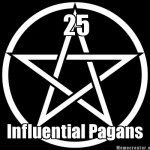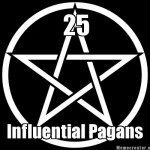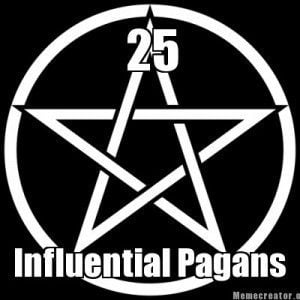 Who doesn’t love a good list and a short history lesson at the same time? Modern Paganism has been influenced by countless people over the past 200 years, but only twenty-five of them (give or take) made my list. Today’s installment looks at Ten Americans (sorry Canada) who have made (and in most cases continue to make) significant contributions to the development and practice of Modern Paganism. If you missed the previous “European Wing” installment please catch up! Part three features my “Top 5” contributors, in order of importance, instead of this cop out alphabetical listing thing I’ve been doing for numbers six through twenty.
Who doesn’t love a good list and a short history lesson at the same time? Modern Paganism has been influenced by countless people over the past 200 years, but only twenty-five of them (give or take) made my list. Today’s installment looks at Ten Americans (sorry Canada) who have made (and in most cases continue to make) significant contributions to the development and practice of Modern Paganism. If you missed the previous “European Wing” installment please catch up! Part three features my “Top 5” contributors, in order of importance, instead of this cop out alphabetical listing thing I’ve been doing for numbers six through twenty.
Coming up with a list of American contributors was a bit more difficult than the European installment. Most American contributors are very “second generation,” it’s a completely different feel and a very different type of list.
The brief “Why they are on this list” parts are not meant to be exhaustive, it’s just a brief thumbnail listing a few accomplishments and reasons for inclusion. Opinions are strictly my own, though you are certainly welcome to share some. This list has a very Wiccan slant, but since Wicca is the largest Pagan denomination that’s probably to be expected.
I desperately wanted to come up with a catchy title for this series, but was unable to. What you got was a descriptive title instead. Without the 25 people listed in this series I think Paganism would look radically different, or perhaps exist in a much more limited way. The people on my list were pioneers and paved the way for sites like this to exist today.
AMERICAN WING
Ask Me Again in Fifteen Years:
Teo Bishop
T. Thorn Coyle
Orion Foxwood
Patrick McCollum
Diana Paxson
Christopher Penczak
Name I Most Wanted to Put on this List But Couldn’t Justify:
Jack Parsons
First One Out, or Number Eleven:
Marion Zimmer Bradley
Please remember, this is one part of a three part series. If you don’t see a favorite there may very well be a reason for that.
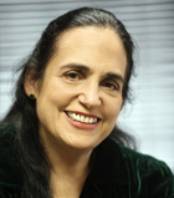 Who is she?: Margot Adler (1946-present), Journalist, High Priestess, and author of Drawing Down the Moon.
Who is she?: Margot Adler (1946-present), Journalist, High Priestess, and author of Drawing Down the Moon.
Why she’s on this list: The easy answer to why is that she wrote Drawing Down the Moon, one of the most influential books about Paganism ever. What made DDtM so unique was that it wasn’t simply a “how to” book, it was an overview of North American Paganism, and the first look at the origins of Modern Paganism and Witchcraft. While DDtM is a bit dated in 2013 (first published in 1979, though updated every few years), time has neither diminished its importance or influence. Adler remains an active participant in the Pagan Community, speaking at public events and continuing to write, all while still writing and reporting for National Public Radio. (Every time Adler is on All Things Considered I usually stop whatever it is I’m doing and start pointing wildly at the radio.)
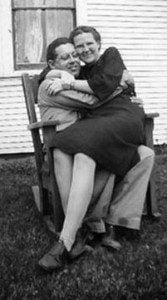 Victor and Cora Anderson (Victor 1917-2001, Cora 1915-2008), founders of the Feri Tradition.
Victor and Cora Anderson (Victor 1917-2001, Cora 1915-2008), founders of the Feri Tradition.
Why they are on this list: It sometimes seems like every important Craft tradition arose in Great Britain, but that’s not the case. The Anderson’s Feri Tradition is an American Witchcraft tradition, fueled by Hawaiian Magick, sensuality, and the poetry of Victor Anderson. While Feri is not as widespread as its British cousins, it’s had a huge influence on Modern Paganism as a whole due to the prominence of many of its initiates (people such as Gwydion Pendderwen, Starhawk, and T. Thorn Coyle). The Feri Tradition was also a huge influence on Reclaiming, and some of its ideas and practices can be seen in multiple Pagan books.
 Who is he: Isaac Bonewits (1949-2010), author, Druid, and Pagan scholar.
Who is he: Isaac Bonewits (1949-2010), author, Druid, and Pagan scholar.
Why he’s on this list: Have you ever heard the term “Neo-Pagan?” That’s Issac, but he’s influence on Modern Paganism transcends that one little term. He was the first (and only) person to receieve a Bachelor’s Degree in Magic from the University of California at Berkeley, an experience which lead to the writing of Real Magic: An Introductory Treatise on the Basic Principles of Yellow Magic, one of the early essentials of American Paganism and magick. Bonewits was an initiated Witch and a member of the Reformed Druids of North America before going on to start Ár nDraíocht Féin (probably better known as ADF, or A Druid Fellowship), currently the largest Pagan Druid group in North America. Bonewits was a tireless teacher, writer, and sometimes musician, whose influence on Paganism was as large as his personality. You are missed my friend.
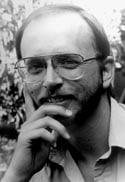 Who is he?: Scott Cunningham (1956-1993), Wiccan author, most famous for Wicca: A Guide For the Solitary Practitioner.
Who is he?: Scott Cunningham (1956-1993), Wiccan author, most famous for Wicca: A Guide For the Solitary Practitioner.
Why he’s on this list: I think I’m only beginning to understand just how revolutionary it was to title Cunningham’s book on Solitary Practice Wicca back in 1988. Up until then the word Wicca was more a whisper than a book genre. Sure there were books on Witchcraft, but Wicca? Cunningham’s book opened the floodgates and began a dialogue that is still ongoing. If that weren’t enough Cunningham’s “Encyclopedia Series” are standard reference works for using oils, herbs, incenses, metals, rocks, and crystals. Solitary Practitioner has become one of the best selling “how to” books of all time, and continues to be highly influential. In 2009 Llewellyn released Cunningham’s Book of Shadows, showing just how popular Cunningham remains nearly twenty years after his death.
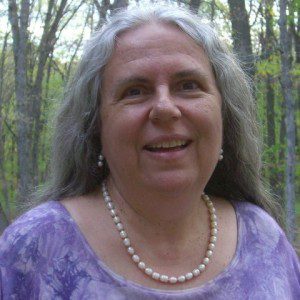 Who is she?: Selena Fox (1949-present), founder of Circle Sanctuary, Pagan teacher and activist.
Who is she?: Selena Fox (1949-present), founder of Circle Sanctuary, Pagan teacher and activist.
Why she’s on this list: If all Selena had ever done was simply set up the first Pagan Cemetery in the United States and win the lobbying effort to include the pentagram on the list of religious symbols allowed on military headstones she’d have made this list, but those are only two of her many accomplishments. Selena is the founder of Circle Sanctuary, a non-profit church and nature preserve run entirely by Pagans. She’s the force behind Circle’s magazine, one of the oldest and most enduring Pagan magazines in the United States, and is the editor of the Circle Guide to Pagan Resources, until the age of the internet an essential networking tool. She’s also a popular teacher and lecturer, and has participated in the World Parliament of Religions. She’s also one of the most warm and energetic people I’ve ever met.
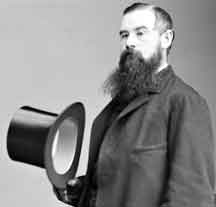 Who is he?: Charles Godfrey Leland (1824-1903), Folklorist and author of Aradia.
Who is he?: Charles Godfrey Leland (1824-1903), Folklorist and author of Aradia.
Why he’s on this list: Leland was an American born folklorist best known in Pagan circles for the books Aradia: Or the Gospel of the Witches and Etruscan Roman Remains, books that are still studied and agonized over 100 years after their initial publication. Aradia is one of the most influential texts in the history of Modern Pagandom, and while the Witchcraft in Aradia is a bit more mean-spirited than modern varieties, there are still many similarities. Much of the material in Aradia has been adapted and re-worked over the years, extending its influence even further. The Charge of the Goddess is found in Aradia, with the more famous Doreen Valiente version using much of the language originally translated from the Italian by Leland. There are many arguments about the historical veracity of Aradia, but no doubts about its influence.
 Who is she?: Silver Ravenwolf (1956-present), author of To Ride A Silver Broomstick and Teen Witch.
Who is she?: Silver Ravenwolf (1956-present), author of To Ride A Silver Broomstick and Teen Witch.
Why she’s on this list: Silver has become a polarizing figure in many Pagan circles, but to an entire generation she was an early entry point into Paganism and Witchcraft. To Ride a Silver Broomstick was an timely and influential work, contributing to and benefitting from the 90’s Pagan boom. I’m not a huge fan of Teen Witch either, but it began a new genre in Pagan books, and introduced a lot of young people to Modern Paganism. Despite the criticisms leveled at books such as Teen Witch there can be no denying that Ravenwolf is a tremendously talented writer, She’s also been one of the most popular Pagan authors in the world for two decades now. Love it or hate it, Silver’s version of Witchcraft has left a lasting mark.
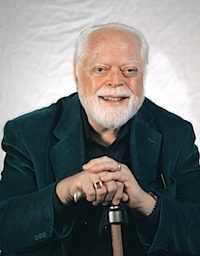 Who is he: Carl Weschcke (1930-present), President of Llewellyn Worldwide.
Who is he: Carl Weschcke (1930-present), President of Llewellyn Worldwide.
Why he’s on this list: Llewellyn is responsible for publishing Lady Sheba’s Book of Shadows, Cunningham’s Wicca, and Ravenwolf’s Broomstick, all books that forever changed Modern Paganism, and none of that happens without Weschke’s purchase of Llewellyn Publications back in 1961. Llewellyn has been the largest and most influential New Age/Pagan publishing house for the last couple of decades, and continues to release important and popular work. There are few people within Pagandom who have not read a Llewellyn book and I’ve seen few Pagan libraries without one of those little crescent moon symbols somewhere on the shelf. In addition to Pagan-focused materials, Llewellyn is also a leader in publishing books on astrology, the super-natural, and a wide range of New Age disciplines. Llewellyn brought competent editing and marketing to Pagan publishing, changing it forever.
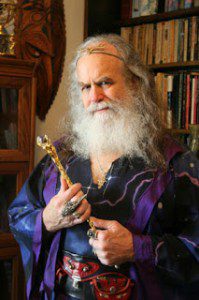 Who is he?: Oberon Zell-Ravenheart (1942-present), founder of the Church of All Worlds and Green Egg Magazine.
Who is he?: Oberon Zell-Ravenheart (1942-present), founder of the Church of All Worlds and Green Egg Magazine.
Why he’s on this list: Oberon was one of the first individuals to realize that Witches, Wiccans, Druids, and Heathens were all a part of the same Pagan tree, indeed Oberon was one of the first people to use the word “Pagan” to describe our very diverse spiritual movement. He did a lot that uniting in the pages of The Green Egg, one of the most influential Pagan magazines in the States. (Forget the articles, my favorite part of the magazine was always the letter column!) Green Egg was also the mouthpiece for The Church of All Worlds, one of the first (if not the first) legally recognized Pagan churches, and based in part on the book Stranger in a Strange Land by sci-fi scribe Robert Heinlein. In addition to founding a church and publishing a magazine Oberon was one of the first people to propose the Gaia Theory. He’s also written several books and started an online magic academy, The Grey School of Wizardry. It’s impossible to talk about Oberon without mentioning his wife Morning Glory who popularized the term and concept polyamory.
 Who are they?: Internet pioneers Wren Walker and Jason Pitzl-Waters.
Who are they?: Internet pioneers Wren Walker and Jason Pitzl-Waters.
Why they are on this list: There’s no doubt that internet has changed Paganism. I can remember a time in the 1990’s when most of us were still connecting through letters, magazine columns, and bulletin boards at the local New Age Bookstore. Today we connect and share information in seconds instead of weeks, and internet personalities have become as important as traditional writers. One of the first real changes in how Pagans connect with one another occurred with the founding of The Witches Voice by Wren Walker and Fritz Jung back in 1997. The Witches Voice was one-stop shopping to find other Pagans, festivals, and supply stores. There was nothing like it before, and nothing like it since. It was (and remains) an invaluable source for information and networking.
 I have a feeling that Jason is not going to like being on this list, but The Wild Hunt has had a huge influence on Paganism over the nine years its of existence. Until The Wild Hunt, Pagan news was sporadic and spread over a wide range sites. Jason and his crew of writers write about Paganism as insiders as well as journalists. There’s no sensationalism, no misplaced outrage, just intelligent commentary about issues and ideas that effect Pagandom on a global scale. Jason and Wren weren’t the first or only people to bring us into the new media age, but they are among the most influential.
I have a feeling that Jason is not going to like being on this list, but The Wild Hunt has had a huge influence on Paganism over the nine years its of existence. Until The Wild Hunt, Pagan news was sporadic and spread over a wide range sites. Jason and his crew of writers write about Paganism as insiders as well as journalists. There’s no sensationalism, no misplaced outrage, just intelligent commentary about issues and ideas that effect Pagandom on a global scale. Jason and Wren weren’t the first or only people to bring us into the new media age, but they are among the most influential.
Next: My Top 5


